Tip, Tap, Top...
The sound of the drop echoed through the silent dark cave
Vibrant paintings brightened the otherwise blank enclave
The silence filled the space like a soothing tone
These are the paradoxes for which Dambulla cave temple is known.
Discover the ancient Dambulla cave temple complex - a UNESCO World Heritage site in Sri Lanka. Learn about the Dambulla cave temple paintings and its history. Included in this travel guide are insider tips on planning a Dambulla cave temple visit.
Caves have always held an element of mystery for me. Whether they are raw caes like the Meghalaya caves or the mysterious Edakkal caves with neolithic etchings or the winding passages of the Belum caves – these structures get my adrenaline pumping. Now imagine what I would have felt when I got a combination of heritage paintings, scores of Buddha statues and stories dating back to the first century hidden in some rock caves of Sri Lanka? Well – that in short is the experience that you have to prepare for as you embark on this tour of Dambulla Cave Temple Sri Lanka.

A UNESCO World Heritage Site, Dambulla Rock Temple or the Dambulla Viharaya is a living Buddhist monastery located in Central Sri Lanka. Popularly referred to as the Golden Temple of Dambulla, this place has the best-preserved wall paintings and Buddha statues in Sri Lanka.
Through this Dambulla travel guide, you will be able to get a glimpse of these magnificent murals as well as important facts about Dambulla caves. In addition, I have included all the tips required to visit the Dambulla cave temple – including the dress code for the temple. the entrance fees to Dambulla royal cave temple, how to get there and where to stay. Time we get started with the tour.
Quick links for your Dambulla caves trip
In case you are looking for some quick links to tours, places to stay and travel accessories for your trip to Dambulla cave temples, you can consider using these online options.
- If you are looking for hotels in Dambulla itself, you will find plenty of options on Booking.com. You can use this Dambulla hotels link to book one for yourself. The same site also, has options for Habarana hotels as well as Sigriya hotels.
- GetYourGuide has several options for tours to Dambulla Cave Temple. You can book them online and get instant confirmation on the site. Here are some recommended Dambulla sightseeing options
- Viator.com offers several tours in and around Dambulla town. Check these highly-rated options for your trip
- For any of your travel needs or general shopping, consider using Amazon through this link.
Disclaimer: This article includes affiliate links. This means that at no cost to you, I will receive a small commission if you purchase through my link. Thank you for supporting me with this.
Contents
- 1 History of Dambulla Cave temple
- 2 Facts about Dambulla cave temple Sri Lanka
- 3 Architecture of Dambulla Rock Temple
- 4 Tour of Dambulla Cave Temples
- 5 Cave Two -Maharaja Lena or the Cave of the Great Kings
- 6 Dambulla Cave temple Dress Code | What to wear inside Dambulla golden cave temple?
- 7 Travel and Photography tips for Dambulla rock temple Sri Lanka
- 8 Common FAQs about Dambulla Cave Temple Sri Lanka
- 9 What is the best way to get to Dambulla Cave temple in Sri Lanka?
- 10 Which is the best time to visit Dambulla rock temple?
- 11 What are the Dambulla cave temple timings?
- 12 What are the Dambulla cave temple entrance fees?
- 13 Where to buy the Dambulla cave temple tickets?
- 14 How many steps are there in Dambulla Cave Temple?
- 15 What is the importance of Dambulla Cave temple Sri Lanka?
- 16 How old is Dambulla Cave temple?
- 17 Who built Dambulla Cave temple?
- 18 What is the difference between Dambulla Cave temple, rock temples of Dambulla and Dambulla Golden temple?
- 19 Where to stay in Dambulla?
History of Dambulla Cave temple
Geologically, the Dambulla caves predate their archaeological significance. The temple came into existence in the 1st century. It was built by King Valagamba of Anuradhapura as a gesture of gratitude when he reclaimed his lost kingdom after 14 years. As the story goes, he sought sanctum among the rocky caverns of Dambulla when his kingdom was usurped by the South Indian tradesmen. During this time, he received a lot of support from the Buddhist monks residing in Dambulla. In 89 BC, he marched back with a mighty army and recaptured his capital. It was after this that he carved the Dambulla cave temple among the very rocks that had sheltered him.

The Dambulla rock temple became an important religious hub by the 11th century. The Sinhalese kings believed that all their problems could be resolved by paying obeisance to the Dambulla temple. Be it drought or battle woes, the kings would come to the rock temples of Dambulla and make a vow. After their problem was resolved, they would make good on that vow and contribute in their own manner to the Dambulla cave temple. Thus, in this manner, many kings added to the cave paintings and sculptures.
One of the significant contributions made to the Dambulla cave temple was by King Nissanka Malla of Polonnaruwa in 1190. He was the one responsible for the golden touch to the cave. He also, added 70 different Buddha statues to the Dambulla Rajamaha Viharaya.

Subsequently, in the 18th century during the reign of the Kandy Kings, the Dambulla caves got a major restoration. Fresh paintings were added and the resulting colorful edifice gave the Dambulla cave temple complex a new name – Rangiri Dambulla cave temple. Rangiri means Golden rock.
The importance of the Dambulla golden cave temple never diminished. Even today, it continues to be a major pilgrimage center. Owing to its ancient Dambulla cave temple paintings and statues, it is has been recognized as an important heritage site – now, of course, a UNESCO world heritage site. In fact, it is this that becomes your major reason to visit Dambulla Cave Temple.
Facts about Dambulla cave temple Sri Lanka

Alright! So I have given away one major reason for you to visit the Dambulla rock temple. However, here are some more amazing Dambulla Cave Temple facts that will up the wanderlust quotient for this particular attraction.
- Dambulla cave temple complex actually has over 80 caves that have been documented. However, it is five of them that are considered to be the key ones.
- The Dambulla golden temple are located on a rocky outcrop which is 160m high.
- There are around 153 Buddha statues, 3 statues of Kings and 4 statues of Hindu Gods including Lord Ganesha and Vishnu that are kept in the five caves of Dambulla Viharaya
- The Dambulla Cave temple paintings are spread over an area of 2100 sq meters. Most of them are gilded – thanks to King Nissanka Malla
- Dambulla caves are the oldest and best-preserved in the whole of Sri Lanka. They are literally over 2000 years old.
And with that, I assume that your eyebrows have disappeared into your hairline. Ah Well! Imagine now witnessing these Dambulla cave temple facts!
Architecture of Dambulla Rock Temple

Created on a 150 m high rock, are the five key Dambulla caves in the form of shrines. Each of the caves has been created such that there is a drip line along the rocks to keep the rain and water away from the caves. They are actually one single entity but have been separated using brick walls into five different caverns.
The entrances of each cave have carvings and triangular gables along with arched colonnades. This part of the entrance is more a recent phenomenon – added only in 1938. The interiors of the Dambulla cave complex are embellished with vibrant Dambulla cave paintings that tell you various tales from the life of Buddha. Adding further glamour are the 100 plus statues that I mentioned in the Dambulla rock temple facts.

Another recent addition to the temple complex is the Golden Temple of Dambulla. Constructed in the 20th century, this is at the base of the ancient cave temple complex. A giant golden Buddha and a gorgeous pagoda mark this latest inclusion of the Dambulla cave temple complex. The Golden Temple of Dambulla has several oriental features including the sweeping Chinese roofs. This part of the temple is the 2nd entrance of the main Dambulla royal cave temple atop the rock.
Tour of Dambulla Cave Temples
Get ready to now experience the ancient Dambulla cave temple complex. In this section, I will share my entire journey to the Dambulla caves. While you get a taste of the caves, remember to watch out for the little tips that I have gathered from my experience. Those will definitely help you get prepared for your own visit to the Dambulla rock cave temple.
Climbing Dambulla rock
How many steps do you reckon you will need to climb to get to a 150 m high rock?

Well, it is 364 steps to be precise. And they aren’t too difficult either. The Dambulla cave temple steps are actually well-cut into the rock and have sufficient landing spaces are regular intervals all the way to the top. The staircase is covered at certain points, allowing you to rest in shade in case of any rain or harsh sunlight. What is more, is that you can catch a breath at these spaces while enjoying the mesmerizing view around Dambulla.
There are actually two entrances to get atop Dambulla rock. The first one is referred to as the South Entrance or the King’s way. This is where you will be able to get your tickets for cave temple, Dambulla. NOTE – THIS IS THE ONLY COUNTER FOR DAMBULLA CAVE TEMPLE TICKETS. There is no counter on top of the rock and hence, it is best to use this entrance to grab your tickets and climb up to the Dambulla royal cave.

The 2nd entrance is through the Golden Temple of Dambulla. I would highly recommend that you avoid this one when climbing up Dambulla rock as there is no ticketing booth around this. In case you take this one, you will end up having to climb downhill again to the lone Dambulla cave temple ticket counter at the South entrance that I have mentioned earlier. Trust me, you will find yourselves with jelly legs if you make this mistake. Use the Golden temple route on your way down. That way you get to see the best of both views that the two sides of Dambulla rock offer – without straining yourself too much.
The entrance and the Dambulla rock inscriptions

Once you have reached the top, you will see the Dambulla terrace where you will need to leave your footwear to enter the cave temple complex. As you walk through the arched entrance, head towards the rock on the right side. A closer examination will reveal the ancient Dambulla rock inscriptions. This date back to the reign of King Nissankamalla – i.e the 12th century. Written in medieval Sinhalese, it documents the various contributions made by the King to the Dambulla temple caves. It also, details the additions done to the ancient Dambulla Viharaya.

Cave One – Devaraja Lena (The Cave of the Divine King)

The first Lena (cave in Sinhalese) is dominated by a 15m long statue of reclining Buddha. The entire statue has been carved out of the Dambulla rock itself. At his head is Lord Vishnu while seated at his feet is his beloved disciple Ananda. This is where you get the first glimpse of the ancient Dambulla rock paintings. You will see figures of royalty and Buddhist disciples painted all around Ananda, with hands folded in respect to the giant resting Buddha statue.
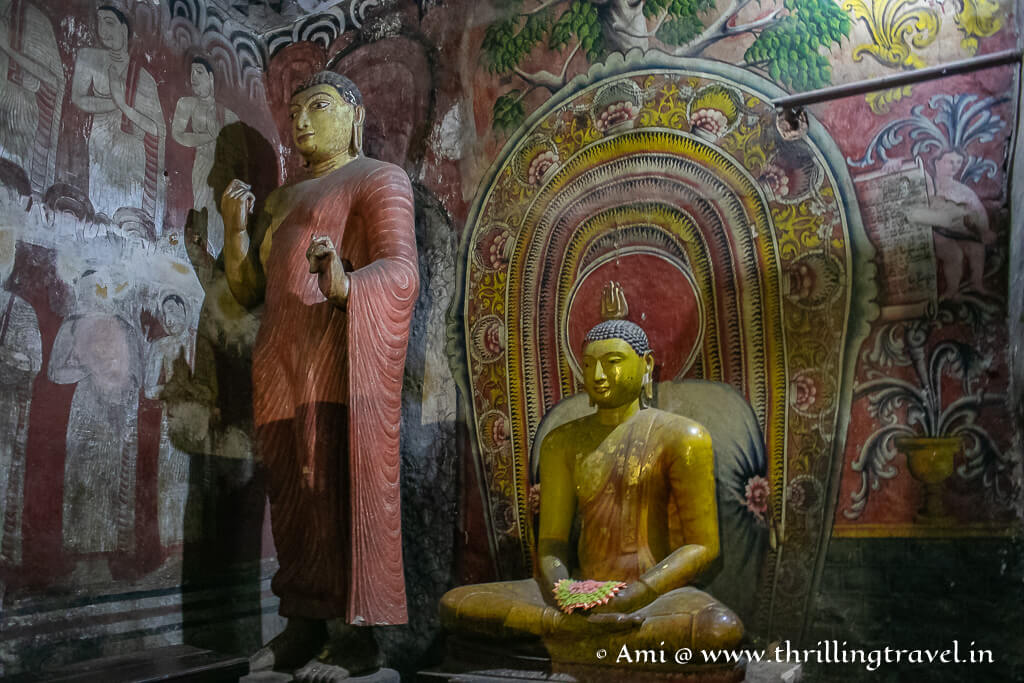
Don’t miss the Brahmi script inscribed over its entrance. This one dates back to the beginning of Dambulla cave temple history – that is the first century.
Cave Two -Maharaja Lena or the Cave of the Great Kings
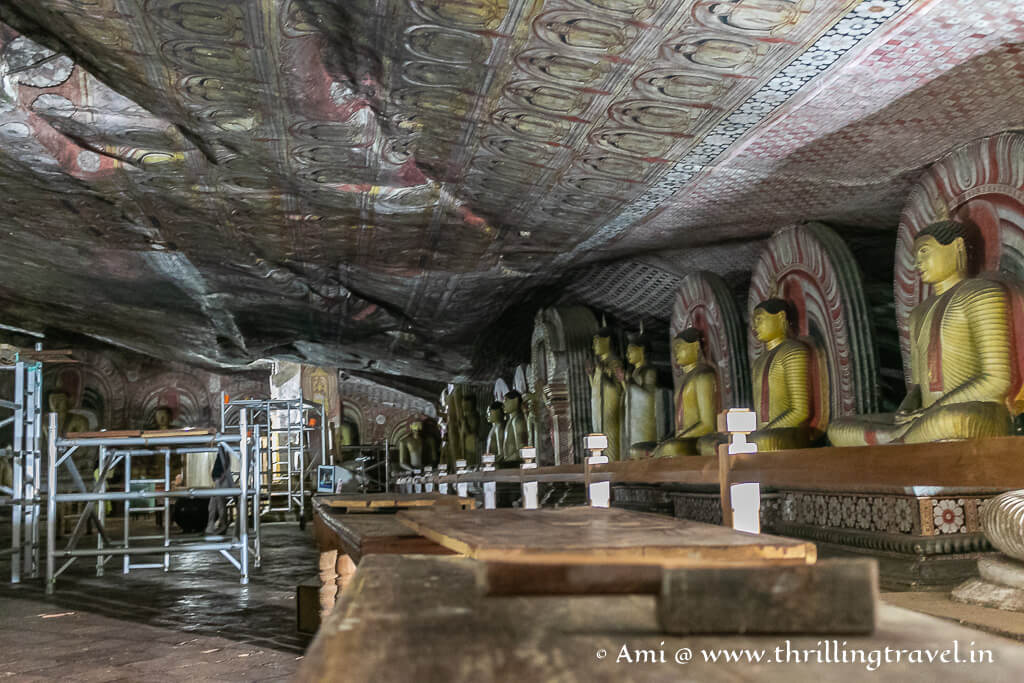
Not only is the Maharaja Lena or the Cave two of Dambulla cave complex the largest, but is probably the most significant among them all. As you enter it, you will be stunned to silence by the sheer number of Dambulla paintings. Every inch of its interior seems to be covered in those vibrant shades of red and gold.
One of the most significant paintings in this cave is a scene from the Buddha’s life where you have a demon – Mara trying to disturb Buddha and break his resolve. You will find this along with the ceiling of this cavern.


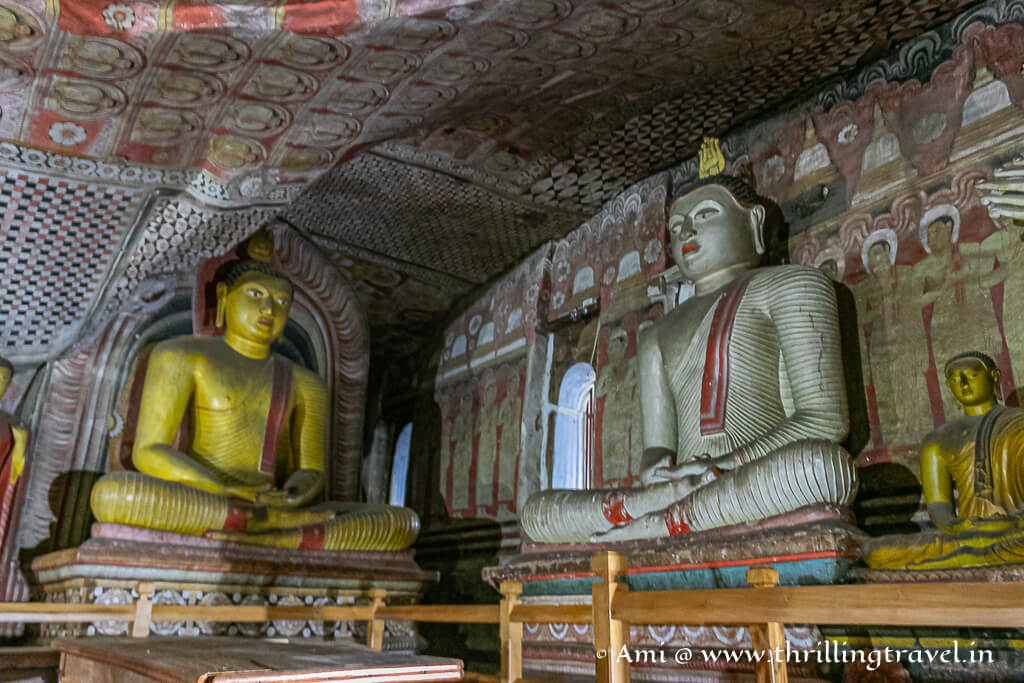
There are 56 statues of Lord Buddha in this cave, of which 40 are seated and the rest are standing. Hidden among them is the statues of the two royal benefactors of Dambulla Viharaya – King Nissankamalla of Polonnaruwa and King Vattagami Abhaya of Anuradhapura. The former King is the one responsible for the gilding of 50 Buddha statues in this cave. There is in fact, an inscription at the entrance of this cave that documents this act of King Nissanka Malla.

This cave is also, one of the most important caves in the Dambulla cave complex for its water pot. Somewhere to the right of the cave, you will see a caged area with the famed water pot of Dambulla cave temple. There is constant water that drips into this Dambulla cave temple water pot. This is owing to a natural spring in the Dambulla rocks, which has never dried. Even when the region had a drought, this water continued to drip down. It is believed that this Dambulla cave temple water pot is miraculous and never dry. The water in it is sought for blessings and is said to have medicinal value.
Of course, one cannot miss the significant pagoda or white dagoba that lies inside this cave and makes it unique. 11 Buddhas surround the Dagoba and add to its religious and serene atmosphere. The cave also, has statues of the Hindu God Vishnu and two other Gods.
Cave Three – Maha Alut Viharaya of Dambulla caves

The name Maha Alut Viharaya translates to the Great New Monastery. This cave has paintings that reflect the typical Kandy style of art that was practiced during the reign of King Kirti Sri Rajasimha. The era goes back to the 1700s. A large sleeping Buddha is one of the key statues in this cave. In addition to that, there are 50 more Buddha statues and one statue of King Kirti Sri Rajasinha.
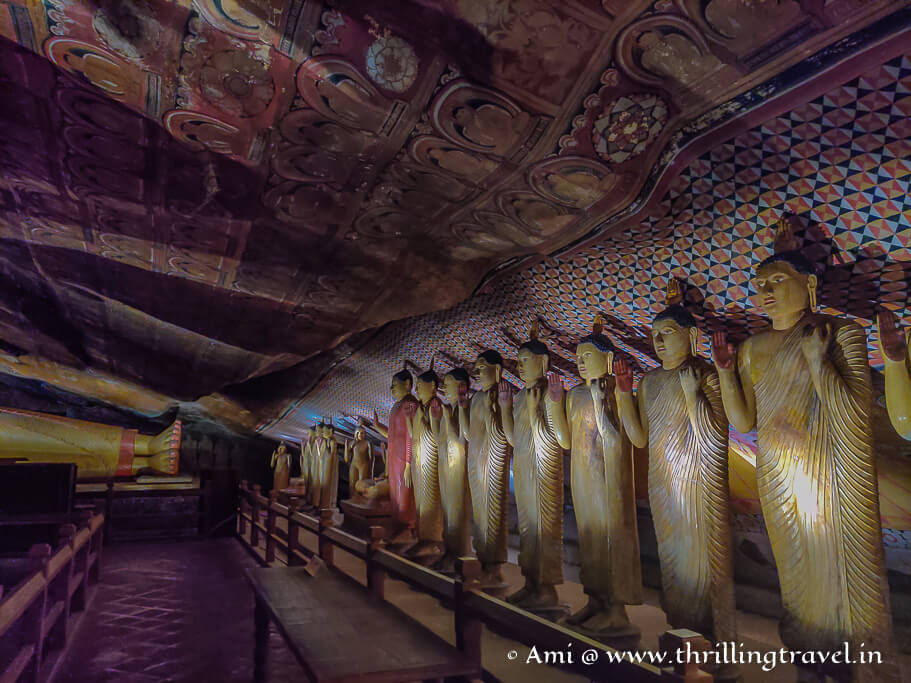
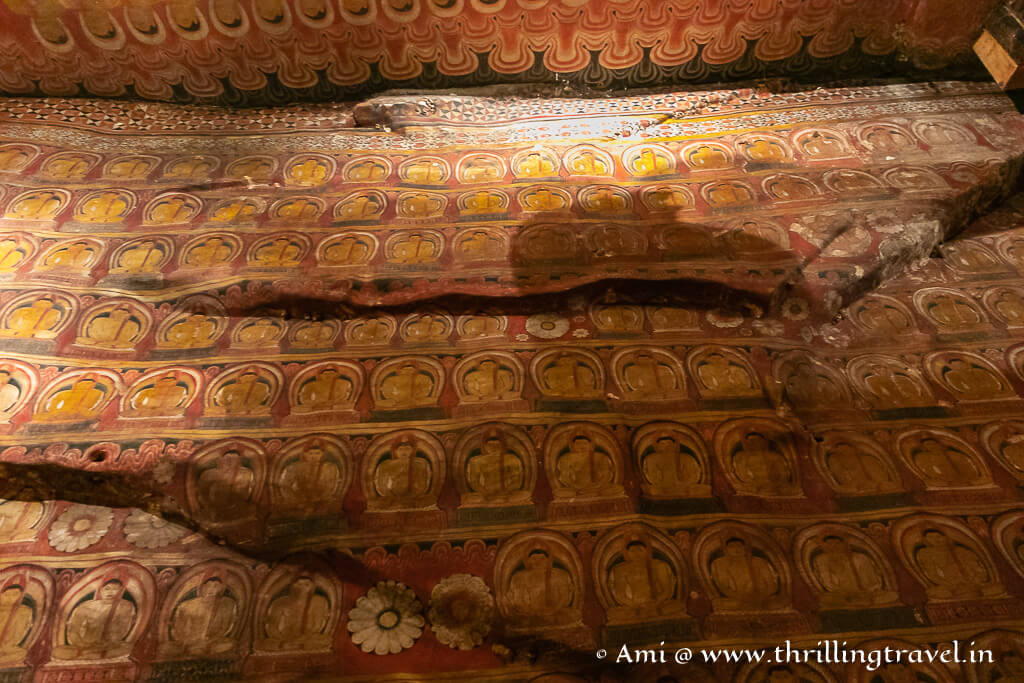
For me, the most fascinating part of this cave where the Dambulla rock paintings of seated Buddha that covered the entire ceiling. In fact, if you ask me, I think the Cave Three of Dambulla temple is the most beautiful of the five caverns.
Cave Four – Paschima Viharaya


The 4th cave of the Dambulla temple stands apart with the abundant use of blue color on its rock paintings. This is one of the smaller caves that open to a seated Buddha. Enclosed in this cave is a dagoba called Soma Chaitya. Folklore has it that this dagoda contains the jewelry that belonged to Queen Somawati – wife of King Valagamba, the initial founder of Dambulla cave temple. This cave also, has a statue of Lord Vishnu.
Cave Five of the Dambulla Cave Temple complex – the Devana Alut Viharaya

The last of the five caves of Dambulla rock temples was used as a storehouse until the early 19th century. It was only then it got converted to a mini shrine. Here too, a reclining Buddha is the spotlight. The seated Buddha statues with a hooded cobra covering them are the other significant ones in this New Monastery cave (Devana Alut Viharaya). Unlike the other four Dambulla caves statues that have been carved straight out of the rock, these statues are made of brick and plaster.
With that, the Dambulla cave temple tour ends. The terrace area has a small pond and a Bo tree within its fold. Once you are done exploring these five caves, you can exit the temple complex and take the other flight of stairs that leads to its newer addition – the Golden temple of Dambulla.
The Golden Temple of Dambulla Sri Lanka

Sadly, this temple was closed by the time I got to it. I had to take the other flight of stairs (the one that goes back to the entrance) to get down. However, I did manage to enter the temple from its street entrance and that is when I saw the golden Dagoba. The pretty Dagoba encloses a small image house and right behind it is the humungous Golden Buddha statue that you can spot from the road itself. The statue of Buddha in Dhyana mudra sits atop the Dambulla museum. I wish I had planned this a little better – I might have known what was inside the museum.
Well, in any case, I am glad I saw the most important part of this living UNESCO World Heritage Site in Sri Lanka. I am sure that after this virtual Dambulla cave temple visit, you are planning your own real one. Check out the next section on common FAQs to help you plan your trip to Dambulla caves. And yes, don’t forget to bookmark this Dambulla cave temple guide.
Dambulla Cave temple Dress Code | What to wear inside Dambulla golden cave temple?
Dambulla cave temple dress code is the same as that of Hindu and Buddhist temples. You need to ensure that your shoulders and legs are covered. This applies to both – Men and Women. There are sarongs available at the entrance but it is best to carry your own. Before you enter the temple, you will have to leave behind your footwear. Ideally, it is better to pay LKR 20 and leave it at the official foot stand. If you leave it elsewhere, chances are that they will be stolen by none other – the mischievous monkeys.
Travel and Photography tips for Dambulla rock temple Sri Lanka
- Beware of the monkeys around the Dambulla rock. Usually, they are harmless but they do tend to snatch food or bags.
- Carry enough water for your climb to Dambulla rock temple
- There are no shops through out the climb.
- Restrooms are available only at the Golden temple – that is at the base.
- Wear comfortable shoes that can be easily removed once at the Dambulla temple entrance.
- Flash photography is strictly prohibited. Given the dark interiors, it is best to carry a tripod or a mini stand to stabilize your camera.
- A basic camera lens is good enough for the captures inside the cave
Common FAQs about Dambulla Cave Temple Sri Lanka
What is the best way to get to Dambulla Cave temple in Sri Lanka?
Dambulla is located at a distance of 160 km from Colombo, which is the nearest international airport. From Colombo, you can take a train to Habarana and then, hop into a tuk-tuk, cab or one of the many public buses to Dambulla. The other option is a road trip from Colombo to Dambulla using this route –
Colombo – Negambo – Mirigama – Badagamuva (via central expressway) – Galewela – Dambulla.
The total drive time on the above route is around 3 hours 15 minutes.
If you are planning to visit Dambulla from Kandy, then you can again, use the train to Habarana. Alternately, there are many public buses to Dambulla. You can even hire a car or cab to get to Dambulla. The distance between Kandy and Dambulla is just 70 km and the drive time is around 2 hours. The best route is as below –
Kandy – Matale – Palapathwela – Arangala – Lendola – Dambulla
Which is the best time to visit Dambulla rock temple?
In terms of season, Dambulla rock temple is best enjoyed between December to March, when the weather is cooler and the rainfall minimal. November and May is when Dambulla receives a lot of rain while it gets really hot in April. June to October is relatively drier and one can plan a visit even during these months.
Dambulla cave temple is best enjoyed during early morning or early evening, just before sunset. The cooler temperature makes your climb up much easier.
What are the Dambulla cave temple timings?
Dambulla cave temple opening timings are from 7 am to 7 pm.
What are the Dambulla cave temple entrance fees?
The Dambulla Cave temple entrance fees is LKR 1500 per person.
Where to buy the Dambulla cave temple tickets?
You can buy the Dambulla cave temple tickets at the booth which is located at the South Entrance. This is NOT the entrance that belongs to the Golden temple with the gigantic Golden Buddha. There is no ticket counter at the top of Dambulla rock or at the Golden temple entrance.
How many steps are there in Dambulla Cave Temple?
There are 364 steps from the South entrance to the top of Dambulla rock.
What is the importance of Dambulla Cave temple Sri Lanka?
Dambulla cave temple Sri Lanka has a major religious and historical significance. It is one of the key pilgrimage destinations for Buddhist owing to its live monastery. Historically, this place has rich rock paintings and inscriptions that go back to the 1st century. On account of that, Dambulla cave complex has been classified as a UNESCO World heritage site.
How old is Dambulla Cave temple?
Dambulla cave temple is said to have been built in the 1st century BC
Who built Dambulla Cave temple?
It is King Valagamba of Anuradhapura who has been credited as the first builder of Dambulla Cave temple. Subsequently, the other Sinhalese kings have made contributions to this ancient cave temple.
What is the difference between Dambulla Cave temple, rock temples of Dambulla and Dambulla Golden temple?
Dambulla Cave temple and the rock temples of Dambulla are terms that are used interchangeably for the five ancient caves atop Dambulla rock. On the other hand, the Dambulla Golden temple refers to the newly constructed temple with the giant Golden Buddha at the base of the same rock. This Golden temple serves as access to the five caves above as well as has a Buddhist museum. One can visit it on their way down from the ancient Dambulla cave temple complex.
Where to stay in Dambulla?
You can choose to stay in any of these three towns – Habarana, Dambulla or Sigriya. All of these allow you access to the best places to visit in Dambulla and Sigriya. You will find a variety of hotels that cater to all kinds of budgets and travelers. I personally, stayed at Habarana Village by Cinnamon which has a lovely lake bordering it. The cottages are quite comfortable and the food absolutely delicious. It is best suited for families and luxury travelers.
For Budget travelers, there are several hostels available like One more night and Dignity Villa. Jetwing Lake is another option for mid-price -luxury stay.
Before you go, Pin This




Popularly referred to as a Restless Ball of Energy. My Mom refuses to entertain my complaints about my equally restless daughter & assures my husband that I was born with a travel bug.
I am a Post-Graduate in Marketing by qualification and a travel blogger by passion. Besides travel, I enjoy photography and if you don’t find me at my desk, I would be out playing badminton or swimming or just running. I believe in planning for every long weekend through the year. And when I cannot travel physically, I travel virtually through this travel blog. My travel stories have also, got published on various websites and magazines including BBC Travel, Lonely Planet India and Jetwings. I have recently published my first book – When Places Come Alive – a collection of stories that are based on legends, landscapes, art and culture of a place which is available in both ebook and paperback format.
You might also like these posts –
- A travel guide to Sigiriya Rock Fortress Sri Lanka | The Lion Rock Sri Lanka
- A complete Jaffna Travel Guide | Best places to visit in Jaffna
- Into the arms of Buddha at Nagadeepa Purana Viharaya Sri Lanka
- Along the crumbling walls of Jaffna Fort Sri Lanka
- Exploring Galle Fort in a day, Sri Lanka
- Beach Hopping on South Coast of Sri Lanka: From Mirissa to Galle
- Things to do in Mirissa, Sri Lanka
- Things to do in Hikkaduwa, Sri Lanka
